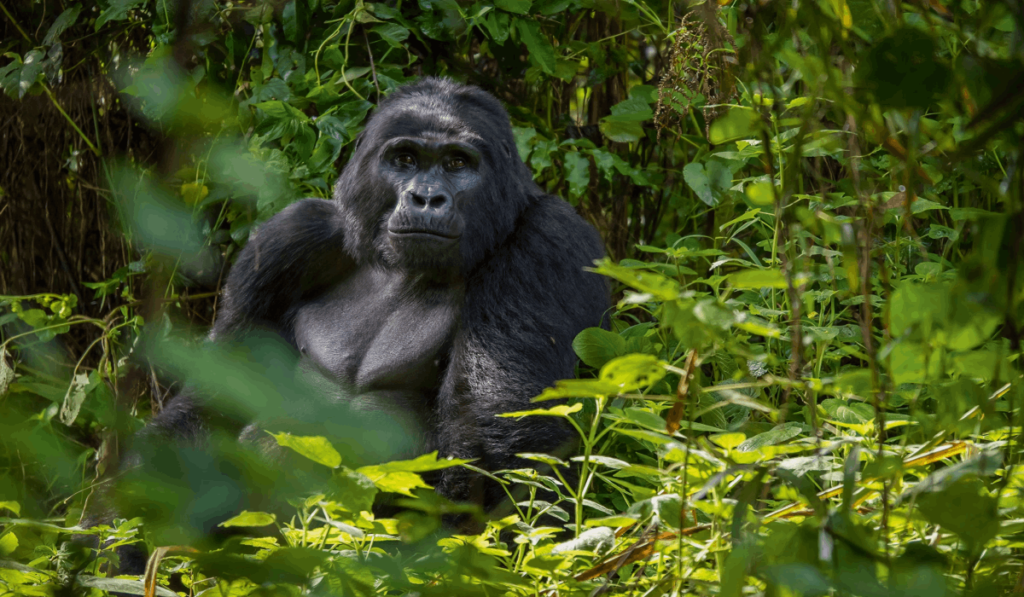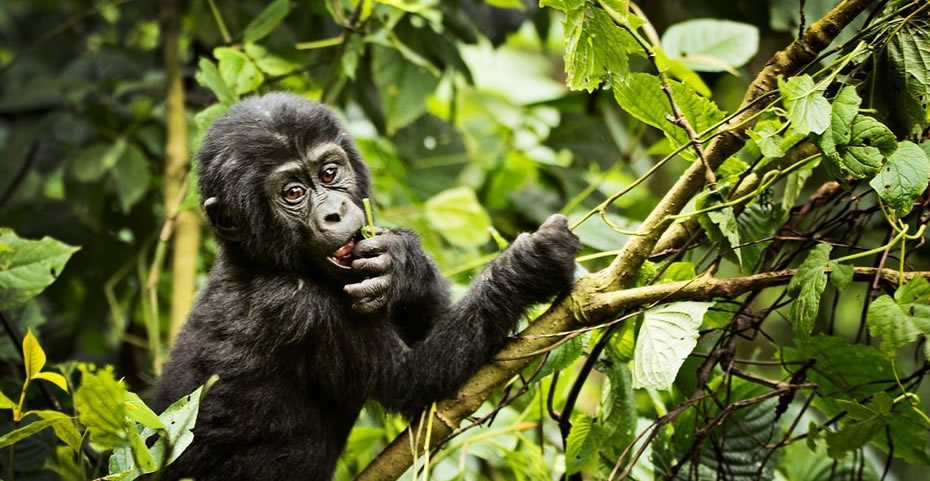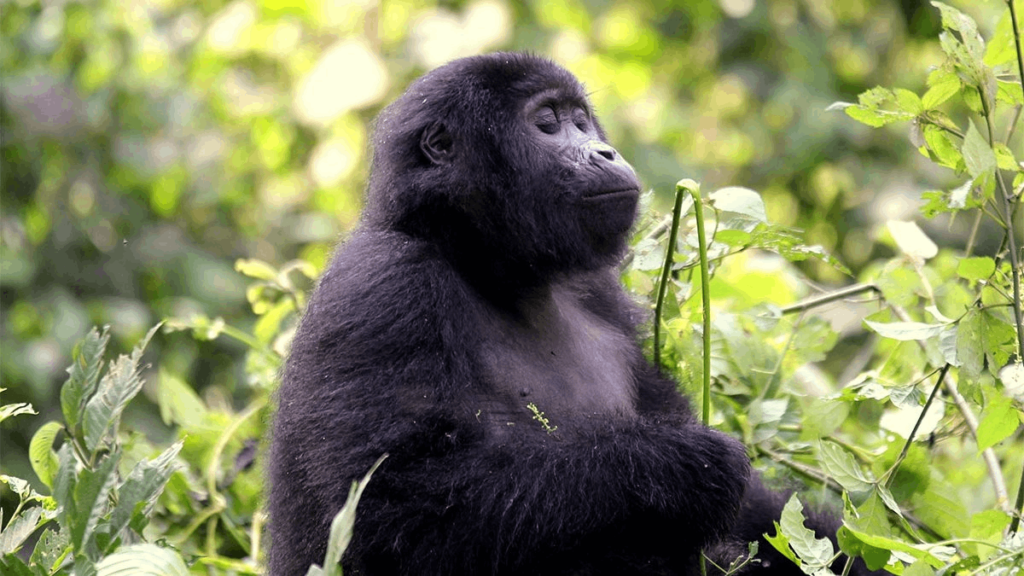What is gorilla trekking
What is trekking with gorillas? Trekking through deep forests in pursuit of gorillas in the wild is known as gorilla trekking. Walking through rivers, streams, dense forests, and steep slopes is all part of the experience before coming upon a family of gorillas. Park Rangers lead gorilla treks, and they frequently make makeshift trails through the undergrowth using machetes. One of the most incredible ways to experience Africa’s wildlife is through gorilla trekking. Compared to game drives to see the big five (lions, buffalo, rhinos, leopards, and elephants), it is comparable, if not better.
The basics of gorilla trekking
Because gorilla trekking involves an interaction with a creature that resembles or behaves like us humans, it is more expensive and unique. Apart from their resemblance to humans, gorillas are typically endangered primates, which adds to the allure for travelers to get a close interaction with them.

You are only permitted to spend an hour with the gorillas after tracking them. You could stare at a group of gorillas for the entire day if there was no time limit. Their family structure and conduct seem so familiar. You will witness the cheeky and obstinate little ones scaling small branches, the dowager females nursing their young, the adults grooming one another, and the alpha silverback always watching out for any troublemakers. Gorillas eat and sleep for the most of the day. Every member of the colony builds a nest for the night as the day comes to a conclusion, with the exception of the mothers who sleep with their babies. A silverback gorilla is in charge of each gorilla troop. The family is shielded by silverback gorillas against a variety of trespassers, including as stray males and leopards. A charismatic and exemplary leader is a silverback gorilla. Members of the group who exhibit disobedience are promptly brought to order. You will discover that the silverback gorilla has exclusive rights to all of the group’s females when you read our article about gorilla mating.
What to anticipate when walking with gorillas?When you’re watching the primates, the Park Rangers will be there to help. Remember to bring your camera. When taking pictures of gorillas, avoid using flash as it may alert them. Never dine in close proximity to gorillas and maintain a minimum of 7 meters gap between you and them. Recall that there won’t be a fence dividing you and the primates. You might find yourself wanting to touch them if they choose to stroll quite near to you. Refrain from touching gorillas and keep your distance from young ones to prevent disturbing mom or, worse, the silverback. Despite appearing occupied, the silverback will be observing your every action. Since gorillas are typically placid primates, gorilla charging is quite uncommon. They might engage in mock charge as a way to reclaim control. Never flee from a gorilla that charges at you. Just keep your head down and behave obediently till it passes.
As was already said, gorilla numbers have decreased during the past century by more than 50%. The three biggest threats to them are human diseases, poaching, and habitat degradation. Gorillas are still killed down in Central Africa and their meat sold to zoos or kept as pets. To safeguard primates, groups like the Mountain Gorilla Fund and the Dian Fossey Gorilla Fund put out great effort.
What makes going gorilla trekking recommended?
In zoos, gorillas are only found in the Western Lowlands. Only in their natural habitats can the remaining three subspecies—the Mountain, Cross River, and Eastern Lowland gorillas—be observed. Since gorillas are What is the purpose of gorilla tracking?rare, it’s exhilarating to witness them in the wild. The fact that gorillas are all endangered makes seeing them in the wild all the more remarkable. Since gorilla trekking is one way to support the conservation of gorillas, it is also significant. The proceeds from gorilla permits are used to fund infrastructure projects for nearby communities, the training of Park Rangers, and the prosecution of poachers. These communities are less inclined to damage gorillas once they realize the advantages of tourism. And last, among our closest cousins are gorillas. They and we have 98% of the same DNA. Why visit elephants and overlook a species that resembles us humans in both appearance and behavior? In addition, tracking gorillas is even more enjoyable since it takes you far into Africa’s jungles, where you may find untainted areas, birds, smaller primates, and other unusual animals. I think you would find this post regarding gorilla safari costs to be interesting.
Where to go trekking with gorillas
There are gorilla trekking programs in several African nations. You need to choose the gorilla subspecies that piques your curiosity. The rain forests and marshes of West and Central Africa are home to Western Lowland Gorillas. Cross River gorillas are restricted to Nigeria and Cameroon. The Democratic Republic of the Congo is home to the largest gorilla subspecies, the Eastern Lowland Gorillas. Rwanda, Uganda, and the Democratic Republic of the Congo are home to mountain gorillas.
Gorilla tracking: what is it?The most well-liked tourist activity is trekking with mountain gorillas. Why? because they reside in places with more developed infrastructure and easy access. The Western lowland gorillas inhabit extremely isolated and impenetrable forests. It can take weeks of traveling through incredibly dense jungles to reach them.

Trekking with mountain gorillas is also typically safer. Gorilla trekking is usually safe in Rwanda’s Volcanoes National Park and Uganda’s Bwindi Impenetrable National Park. The two national parks are regarded as some of the top locations for gorilla viewing. When you contrast that with the unrest in some areas of West and Central Africa, it becomes clear why travelers feel better at ease going on gorilla treks in those two nations. We strongly advise gorilla trekking in the Democratic Republic of the Congo’s Kahuzi-Biega National Park once you’ve seen mountain gorillas. You’re going to see unspoiled nature and an aspect of Africa that will astound you. The biggest gorilla species in the world will be encountered, which is the best part. You might peruse a piece about organizing a reasonably priced gorilla trekking experience.
When is the best time to trek with gorillas?
There is gorilla trekking available year-round. But since the primates are found in rain forests, the dry seasons are the greatest times to see them. Near the equator are Rwanda, Congo, and Uganda. This What transpires when trekking with gorillas?indicates that there are two wet and two dry seasons there. Typically, the first dry season begins in December and ends in early March. June marks the beginning of the second rainy season, which concludes in early October. Because the primates live in rain forests, it is crucial to remember that it could shower at any time of year. Africa’s rainfall patterns have also altered due to global warming. Therefore, rain can fall during the arid seasons as well. Because the jungle is less dense and rain does not hinder the final encounter with the primates, tourists prefer the dry season. Less mud on the woodland pathways means less opportunities for trips.

is required for trekking with gorillas?
The purpose of gorilla trekkingEven though gorilla trekking is accessible to anyone, hiking still requires physical fitness. You should read up on gorilla trekking for the elderly if you’re elderly, infirm, or otherwise incapacitated. In addition, you must be physically and psychologically ready to finish the task in spite of the difficulties that lie ahead. Packing appropriate hiking boots, double-layered socks, gaiters, rain jackets, and bug repellents is part of preparation. When heading out to track gorillas, remember to pack a light food and plenty of water. Human diseases can affect gorillas. No one will be permitted near the gorillas if they have the flu, a cold, or any other contagious illness.
How likely is it that you will see gorillas? Seeing mountain gorillas in their natural habitat is now possible in over 98% of cases. This is as a result of trackers being dispatched before travelers. By using radio calls, this advance party of trackers assists in pinpointing the gorilla group’s exact location and directs the team leading the tourists. While there’s no assurance you’ll spot the primates while tracking, your chances are rather good.



